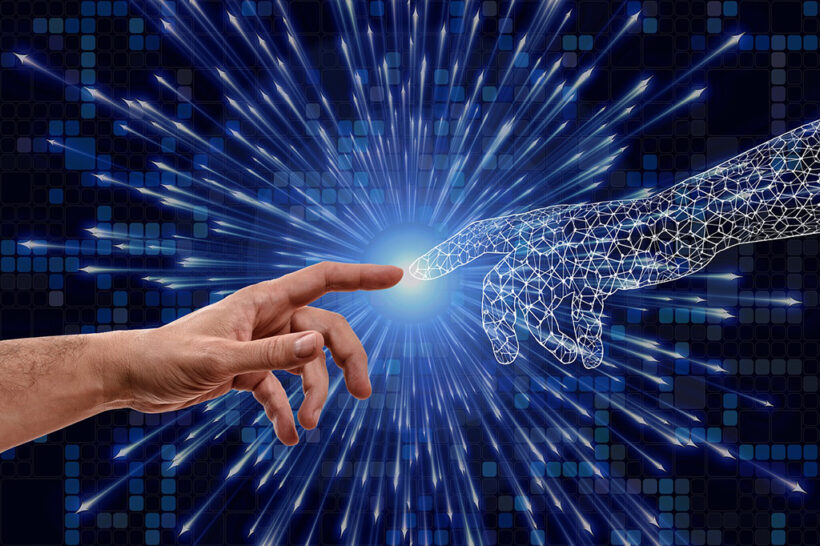Social networks are a very old human practice. With the emergence of the internet, they have gained a global strength and formats unprecedented in history. However, the most common view of the effect of social networks on contemporary societies is rather negative. The fake news that reinforces unscrupulous extreme right-wing electoral campaigns; the manipulative use of the networks to favor the consumption of futility; the presence of ‘influencers’ with shallow and appealing content gaining millions of followers…It is unsettling to imagine that social networks reinforce an old world of unconsciousness, superficialities, dehumanizing and anti-democratic ideas. Yes, this is largely a majority profile of social media today, but this can change completely if we occupy the networks and make them fulfil what may be their historical destiny.
By Débora Nunes with Vicente Aguiar and Marcos Arruda
The thinker Pierre Teilhard de Chardin, who died in 1955, without seeing anything of the Internet or social networks, foresaw their emergence. By identifying several “layers” of life on planet Earth – Hydrosphere, Geosphere, Biosphere – he also identified the Noosphere as the sphere of human beings, bearers of a reflective, prospective, questioning, propositional and critical conscience. Thus, the Noosphere would consist of a civilizing sphere of collaboration and lovingness. To understand this prognosis it is necessary to know that Teilhard de Chardin, a paleontologist, saw cosmic evolution on planet Earth as a process that went through the Geosphere (before the appearance of life as we understand it today), the Biosphere, (in which life manifested itself and evolved widely until the appearance of homo sapiens sapiens), until the current configuration, the Technosphere, a planet built by human intervention in the Geosphere, the Biosphere and the Noosphere itself.
In this evolutionary process from Matter to Mind, two parallel evolutions are taking place, according to Teilhard: the one leading to ‘hominization’, the biological human species, and the one that is leading to ‘humanization’, or the elevation of the conscience of humanity. Teilhard visualised at least four evolutionary trends of the human species: personalization, socialization, spiritualization and ‘amorization’ (neologism that means being always more loving). In other words, he anticipated the understanding of humans as beings called to love and, therefore, pilgrims on the way to the ever more complex and convergent. We could add today, in coherence with this prognosis, that we are also moving towards being ever more connected.
In 1939, in the book “The Human Phenomenon”, only published after his death, Teilhard described the Noosphere, the next evolutionary stage, as “a film of thought enveloping the Earth, formed of human communications”. When we see images of instantaneous Internet connections across the planet, we can imagine the Noosphere coming to fruition. Unfortunately, although it is collaborative – because of the continuous sharing of freely accessed content, – it is not for the most part loving. On the contrary, its description above shows something dehumanizing in the Teilhardian sense, that is, something that remains in the sphere of biological humanity, and not of a conscious, “humanized” humanity. For Teilhard, who besides being a scientist was a priest, the process of enlargement of conscience would be a process of spiritualization, of commitment to the sense of lovingness of human evolution. The Noosphere thus becomes possible as it expands the understanding of the interconnection of everything and everyone, and of the sacredness of existence. The connection and convergence of human intelligences inspired by lovingness and collaboration would be the basis for the construction of a qualitatively superior civilization.

Image by Geralt in Pixabay
From this vision of cosmic evolution, we can understand the Internet as the babbling beginning of the construction of the self-aware Noosphere, a utopia realized in our current times. Recalling the history of the Internet, either as technology or as social practice, reinforces that notion. Manuel Castells reminds us, for example, in “The Internet Galaxy”, that the true origin of the Internet, in the 60s and 70s, had to it more of a scientific and collaborative than a military or marketing thrust. Indeed, none of logical communication infrastructure (ITCP/IP, HTTP and DNS protocols) was patented by its original authors, imposing access restrictions or commercialization. Quite the contrary: the developers of Internet communication protocols registered them in the public domain and freely shared them with humanity. A good part of them had ties with research groups or collectives who called themselves hippies, communalists, or cyberneticists. However, most had in common a radical discourse about a revolution of the means of information and how we would completely change the world by constructing a worldwide network that would connect people in sharing data, information, and knowledge. All this, in the middle of the 60s and 70s of the last century.
Therefore, it is possible to affirm that the Internet as a technology is one of the most fantastic examples of cooperative international construction, the technical expression of a movement that started from below, constantly fed by a multiplicity of local initiatives in different parts of the world, despite the strong predominance of the Northern countries. A revolutionary technological construction that was not the result of an incremental process, of continuity, but rather the fruit of libertarian thoughts coming from the counterculture movements of that period. The transformations of technology and counterculture were completely intertwined and committed. For many researchers, such as Ted Turner in his classic book “Counterculture and Cyberculture”, we can even state that the true legacy of the sixties generation is to have started the technological and social revolution that we live in today.
However, we can question, following Teilhard’s thought, whether the current Internet would not be acting still and mainly in the sphere of the biological human species, that is, in the process of “becoming reflexive conscious” or becoming truly noospheric. If, in the beginning, the human species, like other mammals, based its life in the interaction with its own tribe, and focused its efforts on the search for the pleasure of feeling its instincts satiated and in escaping from dangers, seeing other species and flocks mainly as enemies, everything was changing with the process of humanization. FOr Teilhard, humanization was based on individuation and socialisation, on the construction of individuality while also developing awareness of otherness and compassion extending beyond the family and to those who are not like me.
If most Internet content still resides in a sphere of superficial individual satisfaction manipulated by corporations and hate speech, and if the Internet today favors “bubbles”, in which each person communicates mainly with their peers, this can change. The Internet can be a powerful evolutionary motor of the humanization process, a framework for the Noosphere, for the expansion of conscience, cooperation and love. If we look hard enough, there is already an endless amount of content on the Internet heading this direction. One is reminded of the interchange in Italo Calvino’s “The Invisible Cities” between the master and the disciple. “Master,” asked the disciple, “how can I survive in this hell?”. The Master answered “Look into hell what is not hell, and help it grow”.
One of the great examples of this are the online communities dedicated to the production of thousands of computer programs that are shared freely through the Internet, such as the GNOME Project (www.gnome.org). Involving more than 300 developers and collaborators based in 59 countries on five continents of the planet, the GNOME project collaboratively produces a graphical interface environment (for desktops) and a set of software applications that facilitate the maximum user interaction with computers. Overlapping development of GNOME’s graphical environment is a process of volunteer software translation composing the desktop for more than 60 languages in the world. This international cooperation effort covers Western languages (like Spanish, French and Portuguese) using the same alphabet, as well as languages that use completely different alphabets ¬ like, for example, Chinese, Greek, Arabic, Hindi and Hebrew. Thus, this type of community maintains the ethics and values of cooperation and technological sharing linked to the origin of the Internet itself and very close to building the Noosphere.

Image by Peggy und Marco Lachmann-Anke in Pixabay
Following these same principles of collaborative production, there is also the global social network that has formed on the Internet to develop a universal and multilingual encyclopedia, known internationally as Wikipedia. With the support of over 104 million registered volunteers from all continents of the planet, the online community of Wikipedia has already managed to produce voluntarily and cooperatively over 59 million encyclopedic articles in over 329 languages and dialects on this planet – 1,095,867 articles in the Portuguese version alone. Each language and dialect has a specific local community that cooperates within this great international undertaking of building encyclopedic entries shared via the Internet. This content generates more than 15 billion hits every month and places the portal of this free encyclopaedia encyclopedia (Wikipedia.org) among the ten most accessed in the world since 2006. Therefore, through the adoption of this model of collaboration among millions of Wikipedians connected via the Internet, it is possible to say that Wikipedia has become the largest and most accessed encyclopedia in the world. All this without counting on the support of companies or governments because this encyclopedia only accepts contributions and donations from individuals via the Internet.
The world of possibilities that the Internet offers to evolve toward love and cooperation with oneself, with others and with the planet extends from the local to the global scale.
Consider that the almost free nature of the Internet favors those who want to get involved in local causes, because of the visibility of voluntary and emancipatory micro-actions has never been so great, as well as the easy access to the search for keywords, especially through Google. For those who want to share goods, rides, ideas, feelings, etc. the same applies, just search as the offer has grown and platforms in this regard have become popular. To form groups for common action and thought, WhatsApp and Telegram groups are a powerful tool, whether conservative or emancipatory. Facebook, Instagram, TikTok and Twitter facilitate the dissemination of any social movement, personal action, or idea.
On a global scale, those who want to meet remotely, in their own language or in many languages at the same time, find tools such as Zoom, GoogleMeet and several others. The creation of spaces in which the human family can meet and recognize one another as “relatives”, as the original peoples say, has never been greater, and translation platforms, simultaneous translations and language rooms in international meetings are particularly useful. The presence of these elements has propitiated an ever more intense connection of planetary citizenship.
So, if today there are technological means of expanding movements committed to love and cooperation, why does the dark side and not the bright side of humanity seems to have more power in the network environment? A thousand answers are possible. Let us look at some of them:
- In the companies mentioned above one can see that the homeland of capitalism monopolizes the means of access and it is no wonder that more business than solidarity and mutual support is accomplished through the Internet;
- The Internet is still a lawless land, so those who have no ethics spread false truths easily and almost always without punishment;
- Superficiality takes advantage of the law of least effort that always accompanies humanity, and thus, those who offer content that distracts and alienates instead of summoning the critical spirit, gain followers much more easily.
Faced with this brief explanatory framework of the premise at the beginning of this text – the Internet at the service of dehumanization and not humanization -, what can be done? How can we help it become a precursor of the Noosphere? There is a fourth explanation for why the Internet is dominated by the right-wing, by superficiality and by the market: the fact that influential people on our side and emancipatory movements still have great resistance to the networks, either because of the average of these people, who are partly unaware of the mechanisms of its technical functioning, or because of the resistance to the “exhibitionism” that the networks promote. Thus, the motto “another world is possible, and it is already under construction”, according to the World Social Forum, has little visibility. Another reason is the degree of energy being put into in the counter-hegemony demands of those who are engaged in overcoming the current status quo: how to have time to expose this on the Internet, to keep the public informed and updated on what is being built? The youth movements have a greater possibility of showing their challenges and possibilities, but they are not the majority.
The challenge of occupying the networks with alternative examples of society, concepts and practices of loving kindness and cooperation to nurture hope and inspire humanity in its evolution is a political challenge. It is a matter of decision.
It is a decision of the movements and a personal decision. To overcome the idea of exhibitionism and egocentrism that the networks convey, let us make ever more visible and more convincing the proposal that we need to occupy the networks so that humanity can better know its evolutionary possibilities. To overcome the technical challenge, intergenerational cooperation needs to go broader and deeper, with the old generations who need help listening more to the young and respecting their way of doing things. Faced with the question ‘to have or not to have time for the networks’, it is necessary to take into account that the expansion of conservative thinking on the Internet requires more hours of work than investing time now in the political dispute of narratives, concepts, images, experiences. To confront the consumerist appeal of the market, one path may be once again to give space to the more advanced youth of the new generation. Their habits of sobriety, consumption of used goods, vegetarianism, and veganism, cycling and sharing goods – just to mention a few avant-garde behaviours – are already building an anti-consumerist culture.
Occupying the networks today is as important as occupying the streets has always been.
Studying them, strengthening alternative initiatives to the big US corporations that dominate the Internet, prioritizing the production of content with renewed language, interacting with the platforms available today, encouraging the progressive camp in their posts, has already showed results. The Brazilian presidential election in 2022 showed how much we have to gain by understanding the networks decisively as an arena of political dispute and acting through them. Of course, the right-wing will act the way it acted in Brexit, in the US, Italian, Israeli, Brazilian and many other elections. Of course, the “market” will continue to surf the networks. Of course, the influencers of superficiality will continue to use any strategy to be heard and seen, since they write little. Nevertheless, what about us? Are we going to enter the virtual world and make it an evolving platform or are we going to win narrowly or lose miserably in the long run?
Progressive internet users of the world, unite!






